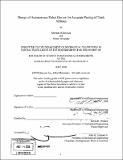Design of autonomous robot device for accurate pacing of track athletes
Author(s)
Liu, Qinyuan (Qingyuan Chen); Hernández, Albert
DownloadFull printable version (17.28Mb)
Other Contributors
Massachusetts Institute of Technology. Dept. of Mechanical Engineering.
Advisor
David R. Wallace.
Terms of use
Metadata
Show full item recordAbstract
Given the health and weight gain concerns plaguing the country, there is currently a great need for products that encourage athletic activity. A robotic pacing device that facilitates running along a track was developed to help fulfill this requirement. The need for this device, determined from interviews and a survey of experienced running athletes and coaches, was found to be substantial for a number of age groups and experience levels of runners. An experimental robot prototype was designed and manufactured to aid in pacing runners around a track. The robot was designed to accurately follow the lines of the track using IR sensors that detect reflectivity of the track's surface. The prototype was tested and optimized to determine a successful control logic that reduced error and the amount of overshoot the robot experiences as it adjusts to follow the lines at high speeds. Large overshoots lead to robot malfunction and breakdown in the logic as the robot reaches curves in the track. The optimized prototype currently has the capability of running full lengths around various shaped tracks that incorporate white lines dividing dark colored lanes at speeds of up to eight miles per hour. In this form, the robot might be useful for beginner runners, runners that are doing distance training, and physical education classes that have access to running tracks. Future versions of the robot pacing device will need to incorporate additional features in order to be useful for the full range of people that want to use this product, including a flexible user interface that allows users to program the robot to their needs, a more sophisticated robot control system that allows for accurate control based on the dynamics of the robot, and a more durable cover that is easily spotted by runners looking straight ahead.
Description
Thesis (S.B.)--Massachusetts Institute of Technology, Dept. of Mechanical Engineering, 2008. Includes bibliographical references (leaf 42).
Date issued
2008Department
Massachusetts Institute of Technology. Department of Mechanical EngineeringPublisher
Massachusetts Institute of Technology
Keywords
Mechanical Engineering.